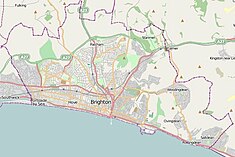75 Holland Road, Hove
| Palmeira Yard, 75 Holland Road | |
|---|---|

The building from the southwest
|
|
| Location | 75 Holland Road, Hove, Brighton and Hove BN3 1JN, United Kingdom |
| Coordinates | 50°49′39″N 0°09′41″W / 50.8276°N 0.1613°WCoordinates: 50°49′39″N 0°09′41″W / 50.8276°N 0.1613°W |
| Built | 1893 |
| Built for | Brighton & Hove Co-operative Supply Association |
| Architect | Thomas Lainson |
| Architectural style(s) | French Second Empire |
|
Listed Building – Grade II
|
|
| Official name: 75 Holland Road | |
| Designated | 31 May 1974 |
| Reference no. | 1187561 |
|
Location within Brighton and Hove
|
|
75 Holland Road in Hove, part of the English coastal city of Brighton and Hove, is now in residential use as loft-style apartments called Palmeira Yard, but was originally a belonging to the Brighton & Hove Co-operative Supply Association, the main cooperative business organisation in the area. Elaborately designed in 1893 in the French Second Empire style by local architect Thomas Lainson of the firm Lainson & Sons, the storage building had built-in stables and was lavishly decorated with terracotta. After a period of ownership by haulage and removals company Pickfords, who used the building for furniture storage, a local architecture firm carried out the conversion into mixed-use live-work units between 2004 and 2006. English Heritage has listed the building at Grade II for its architectural and historical importance.
The seaside resort of Brighton, on the English Channel coast, developed rapidly from the mid-18th century, and by the late 19th century it was a large town was significant regional importance as a commercial centre. Neighbouring Hove developed later in response to Brighton's growth, principally as a residential area with streets of spacious, high-quality houses.
Brighton was a pioneer in the cooperative movement: it adopted Robert Owen's ideas very early, and England's first co-operative store opened on West Street in 1828. A journal, The Co-operator, was started soon afterwards by local doctor William King; it helped inspire the Rochdale Pioneers and other early cooperatives in England. Other associations were formed elsewhere in Brighton and Hove in 1846, 1860 and 1887. By the 1880s, the Brighton & Hove Co-operative Supply Association, based in Hove, was one of the main groups; they needed more space in the town for their operations, especially for storage, and they appointed local architecture firm Lainson & Sons as their in-house architects. The firm consisted of Thomas Lainson, a Brighton man who had designed buildings of all types around the two towns since the early 1860s, and his sons Thomas J. and Arthur.
...
Wikipedia

